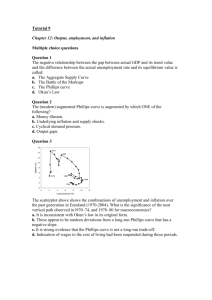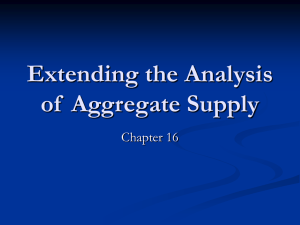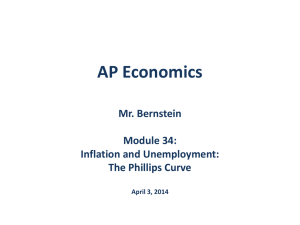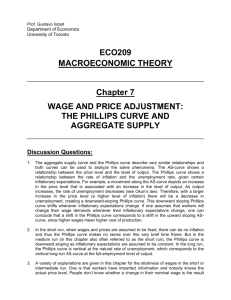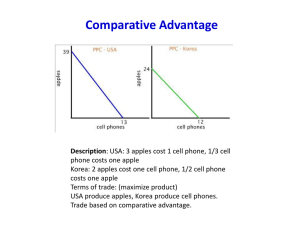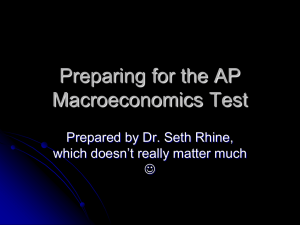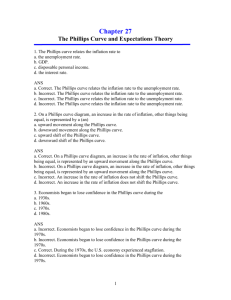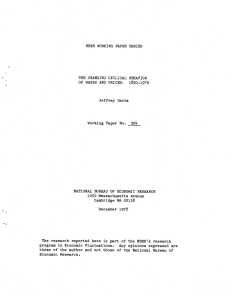Tutorial 9
advertisement
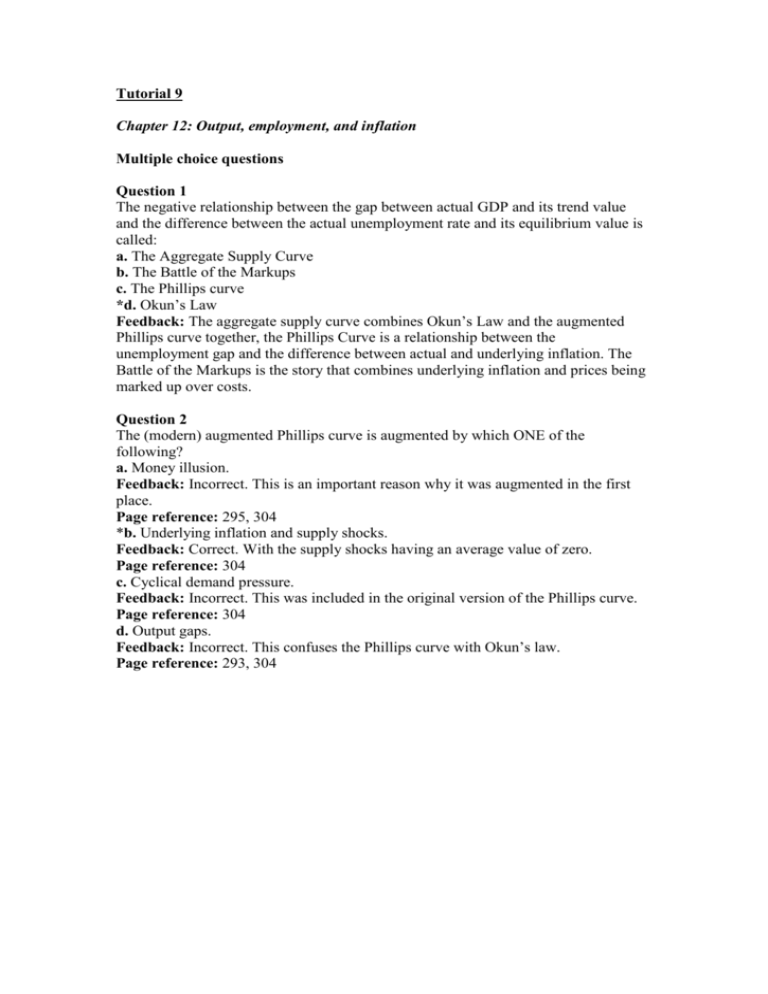
Tutorial 9 Chapter 12: Output, employment, and inflation Multiple choice questions Question 1 The negative relationship between the gap between actual GDP and its trend value and the difference between the actual unemployment rate and its equilibrium value is called: a. The Aggregate Supply Curve b. The Battle of the Markups c. The Phillips curve *d. Okun’s Law Feedback: The aggregate supply curve combines Okun’s Law and the augmented Phillips curve together, the Phillips Curve is a relationship between the unemployment gap and the difference between actual and underlying inflation. The Battle of the Markups is the story that combines underlying inflation and prices being marked up over costs. Question 2 The (modern) augmented Phillips curve is augmented by which ONE of the following? a. Money illusion. Feedback: Incorrect. This is an important reason why it was augmented in the first place. Page reference: 295, 304 *b. Underlying inflation and supply shocks. Feedback: Correct. With the supply shocks having an average value of zero. Page reference: 304 c. Cyclical demand pressure. Feedback: Incorrect. This was included in the original version of the Phillips curve. Page reference: 304 d. Output gaps. Feedback: Incorrect. This confuses the Phillips curve with Okun’s law. Page reference: 293, 304 Question 3 The scatterplot above shows the combinations of unemployment and inflation over the past generation in Euroland (1970-2004). What is the significance of the near vertical path observed in1970–74, and 1978–80 for macroeconomics? a. It is inconsistent with Okun’s law in its original form. Feedback: Incorrect. The variables are different. Page reference: 292, 296 b. These appear to be random deviations from a long-run Phillips curve that has a negative slope. Feedback: Incorrect. Since we now know that inflationary expectations changed together with positive price shocks during this period, these are not ‘random deviations’ about a stable long-run downward-sloping Phillips curve. Page reference: 296 *c. It is strong evidence that the Phillips curve is not a long-run trade-off. Feedback: Correct. This is precisely what Friedman and Phelps had claimed. Page reference: 296 d. Indexation of wages to the cost of living had been suspended during those periods. Feedback: Incorrect. Actually, indexing wages to a measure of the cost of living would speed the shift of the short-run Phillips curve. Page reference: 296 Question 4 WL 1 sL P eY This equation is the description of wage negotiations used in the ‘battle of the markups’. Which ONE of the following explains the difference between the sL – terms on the left and the right side of this equation? a. The left-hand side sL is expected unit labour cost, whereas sL on the right-hand side is the historical ‘normal’ unit labour cost. Feedback: Incorrect. Dividing unit labour costs by the (expected) price level gives us the (expected) wage share. Page reference: 300 b. The left-hand side sL is the expected wage share, whereas sL on the right-hand side is the actual negotiated wage share. Feedback: Incorrect. The negotiated actual wage share does depend on the expected price level. Page reference: 300 Given is the following equation: sL *c. The left-hand side sL is the actual negotiated wage share, whereas sL on the right-hand side is the historical ‘normal’ wage share. Feedback: Correct. The idea is that unions are interested in a ‘fair share’ of productivity. Page reference: 300 d. The left-hand side sL is the unions’ preferred wage share, whereas sL on the righthand side is the employers’ preferred wage share. Feedback: Incorrect. This would not help us, even if it were true, to say what the actual negotiated wage would turn out to be. Page reference: 300 Question 5 Which ONE of the following factors is NOT relevant for the determination of wages set through collective negotiations? a. Productivity gains. Feedback: Incorrect. See the discussion of Equation 12.6. Page reference: 300 *b. Supply shocks. Feedback: Correct. By definition, these are unexpected, so they cannot enter into the negotiation. Page reference: 300 c. The state of the business cycle. Feedback: Incorrect. See the discussion of Equation 12.6. Page reference: 300 d. Underlying inflation. Feedback: Incorrect. See the discussion of Equation 12.6. Page reference: 300 Question 6 Which ONE of the following would NOT result in a shift in the aggregate supply curve? a. Changes in trend GDP. Feedback: Incorrect. See the derivation of Equation 12.11 and Section 12.5.4. Page reference: 304, 308. *b. Stagflation. Feedback: Correct. The AS curve does not shift as a result of stagflation. It is the other way around: stagflation is the result of a shift of the AS curve caused by an adverse supply shock (i.e., a sudden rise in oil prices). Page reference: 304 c. Supply shocks. Feedback: Incorrect. See the derivation of Equation 12.11 and Section 12.5.4. Page reference: 304, 308. d. Changes in underlying inflation. Feedback: Incorrect. See the derivation of Equation 12.11 and Section 12.5.4. Page reference: 304, 308. Open questions: Exercises 6 and 8 from the book. 6. Increasing taxes reduces demand but a VAT increase also acts as a supply shock. Higher VAT means higher prices. Workers will want an increase in nominal wages to compensate them for this increase in the price level; firms may not be able to afford it. The winner of the battle of the mark-ups is not clear. Thus it may affect the equilibrium rate of unemployment as well, if workers are able to protect their real wages. The same applies to other taxes, with varying degrees of intensity: firms with market power will try to pass corporate profits tax on to their customers, depending on the competitive situation in product markets. Workers will resist the loss of purchasing power and demand higher wages. Income tax rises also encourage workers to demand wages increases. 8. See also graph on next page. Denote by U the true equilibrium rate of unemployment. Starting from U , π = π 0 . As the government incorrectly estimates U 0 < U and tries to expand demand, initially the economy moves along the short run Phillips curve. To reduce unemployment to U 0 the government must accept an inflation rate π1 above the underlying inflation rate π 0 , as it moves the economy from point A to point B. But as soon as agents recognize this, underlying inflation is revised upwards (the backward-looking component of underlying inflation catches up) and the short-run Phillips curve is shifted upwards. The government can still keep the unemployment rate at U 0 , however, at the cost of a still higher inflation rate π 2 (point C). Thus, inflation must keep increasing forever, which is evidently not sustainable. Eventually, the unemployment rate must go back to its equilibrium level, which is independent of monetary forces. The long-run outcome of an attempt to lower unemployment below equilibrium is a high inflation rate without any impact on the labour market. Extra question: Exercise 9 from the book. 9. The succession of effects is as follows: So the government can indeed push output up in the short run. This comes at the price of a higher expected inflation. To bring expected inflation back to its old level, the government would have to trigger a recession.
